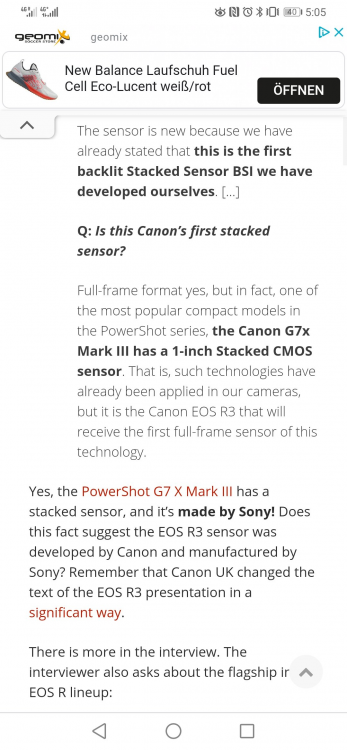
androidlad
Members-
Posts
1,215 -
Joined
-
Last visited
Content Type
Profiles
Forums
Articles
Everything posted by androidlad
-
High iso ultra low light sony IMX sensors like A7S2 A7S-3
androidlad replied to PDerrins2020's topic in Cameras
You can get an A7S3. -
The HDR is simultaneous dual-gain readout of each pixel, it's for stills mode only. Quad Bayer for this sensor is 2 x2 OCL for each pixel for cross-type on-chip AF.
-
There's also a red front record button on GH6 just like S1H, if you know where to look.
-
5720 x 4290 Completely revamped DFD AF that's on par with, and sometimes better than A7S III.
-
Sony sensors use linear 12bit ADC readout in video mode.
-
There are two prototypes being developed, one is 8k capable and the other is not.
-
Actually many of us will be pleasantly surprised when X-H2 arrives. Mark my word.
-
-
After all those years still no camera can come close to Alexa's DR
androidlad replied to ntblowz's topic in Cameras
-
R3 sensor is likely to be manufactured by Sony Semicon: https://www.canonwatch.com/did-canon-make-the-eos-r3-sensor-or-did-they-not/
-
Use CineMatch plugin to generate LUTs to match.
-
Canon on assult? 3 new 8K60p cinema cam with up to 20+ DR
androidlad replied to ntblowz's topic in Cameras
I‘ve seen the prototype, while definitely not 20 stops by ARRI standard, it's still a huge step up due to the multiple gain output. -
Surprise announcement: Canon R5 will be able to output 8K 30P ProRes RAW via HDMI.
-
It doesn't and cannot output 48fps via HDMI, it's not in HDMI spec.
-
Based on information from multiple sources, Canon originally planned to announce this camera as R1. However the Sony A1 was completely unexpected and too competitive. So Canon made a strategic decision to reposition this camera as R3, buying time to develop R1 that can truly compete with A1.
-
GFX100 and GFX100S do not use any pixel-binning. Horizontally it uses full readout of 11604 pixels (possible because of Sony sensors column-parallel ADC), vertically it line-skips 2/3 resulting in 4352 pixels. Then this 11604 x 4352 image is over-sampled to 4K.
-
10bit D-Log and 10bit HLG. Maximum bitrate 150Mbps.
-
Full spec published: https://dronedj.com/2021/04/12/unboxing-video-reveals-dji-air-2s-drone-specifications/ Fixed f/2.8 Aperture FOV 88 degrees, 22mm lens (35mm equivalent) Max Image Size – 20 MP: 5472×3648, 3:2, 5472×3078, 16:9 Video Resolution: 5.4k: 5472×3078 24/25/30 p @10bit 4k Ultra HD; 3840×2160 24/25/30/48/50/60 p @10bit 2.7 k: 2688×1512 24/25/30/48/50/60p @10bit FHD 1920X1080 24/25/30/48/50/60/120 P @10bit
-
You misunderstood. Pixel-binning has a strong anti-aliasing effect (blurring). Especially so for a 3 x 3 pattern.
-
-
The sensor is capable of 3 x 3 pixel-binned 3882 x 2912 at 30fps from full width and height of the sensor. Fujifilm simply did not implement this. Also it does not sound as enticing as "over-sampled 4K" in marketing. Also because of the 3 x 3 pixel-binning, the image will be very soft.
-
https://www.techniknews.net/news/dji-air-2s-drohne-alle-informationen-zur-neuen-drohne-exklusiv/




.thumb.png.cfae84b22fcf7f407eff73e0c50b6ab3.png)